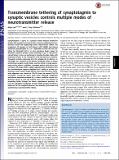| dc.contributor.author | Littleton, J. Troy | |
| dc.contributor.author | Lee, Ji Hye | |
| dc.date.accessioned | 2015-09-08T15:14:19Z | |
| dc.date.available | 2015-09-08T15:14:19Z | |
| dc.date.issued | 2015-03 | |
| dc.date.submitted | 2014-10 | |
| dc.identifier.issn | 0027-8424 | |
| dc.identifier.issn | 1091-6490 | |
| dc.identifier.uri | http://hdl.handle.net/1721.1/98385 | |
| dc.description.abstract | Synaptotagmin 1 (Syt1) is a synaptic vesicle integral membrane protein that regulates neurotransmitter release by activating fast synchronous fusion and suppressing slower asynchronous release. The cytoplasmic C2 domains of Syt1 interact with SNAREs and plasma membrane phospholipids in a Ca[superscript 2+]-dependent manner and can substitute for full-length Syt1 in in vitro membrane fusion assays. To determine whether synaptic vesicle tethering of Syt1 is required for normal fusion in vivo, we performed a structure-function study with tethering mutants at the Drosophila larval neuromuscular junction. Transgenic animals expressing only the cytoplasmic C2 domains or full-length Syt1 tethered to the plasma membrane failed to restore synchronous synaptic vesicle fusion, and also failed to clamp spontaneous vesicle release. In addition, transgenic animals with shorter, but not those with longer, linker regions separating the C2 domains from the transmembrane segment abolished Syt1’s ability to activate synchronous vesicle fusion. Similar defects were observed when C2 domain alignment was altered to C2B-C2A from the normal C2A-C2B orientation, leaving the tether itself intact. Although cytoplasmic and plasma membrane-tethered Syt1 variants could not restore synchronous release in syt1 null mutants, they were very effective in promoting fusion through the slower asynchronous pathway. As such, the subcellular localization of Syt1 within synaptic terminals is important for the temporal dynamics that underlie synchronous and asynchronous neurotransmitter release. | en_US |
| dc.description.sponsorship | National Institutes of Health (U.S.) (Grant NS40296) | en_US |
| dc.description.sponsorship | Korea (South). Ministry of Science, ICT and Future Planning (National Research Foundation of Korea. Basic Science Research Program Grant 2013R1A1A1010839) | en_US |
| dc.language.iso | en_US | |
| dc.publisher | National Academy of Sciences (U.S.) | en_US |
| dc.relation.isversionof | http://dx.doi.org/10.1073/pnas.1420312112 | en_US |
| dc.rights | Article is made available in accordance with the publisher's policy and may be subject to US copyright law. Please refer to the publisher's site for terms of use. | en_US |
| dc.source | National Academy of Sciences (U.S.) | en_US |
| dc.title | Transmembrane tethering of synaptotagmin to synaptic vesicles controls multiple modes of neurotransmitter release | en_US |
| dc.type | Article | en_US |
| dc.identifier.citation | Lee, Jihye, and J. Troy Littleton. “Transmembrane Tethering of Synaptotagmin to Synaptic Vesicles Controls Multiple Modes of Neurotransmitter Release.” Proc Natl Acad Sci USA (March 9, 2015): 201420312. | en_US |
| dc.contributor.department | Massachusetts Institute of Technology. Department of Biology | en_US |
| dc.contributor.department | Massachusetts Institute of Technology. Department of Brain and Cognitive Sciences | en_US |
| dc.contributor.department | Picower Institute for Learning and Memory | en_US |
| dc.contributor.mitauthor | Littleton, J. Troy | en_US |
| dc.contributor.mitauthor | Lee, Jihye | en_US |
| dc.relation.journal | Proceedings of the National Academy of Sciences | en_US |
| dc.eprint.version | Final published version | en_US |
| dc.type.uri | http://purl.org/eprint/type/JournalArticle | en_US |
| eprint.status | http://purl.org/eprint/status/PeerReviewed | en_US |
| dspace.orderedauthors | Lee, Jihye; Littleton, J. Troy | en_US |
| dc.identifier.orcid | https://orcid.org/0000-0001-5576-2887 | |
| mit.license | PUBLISHER_POLICY | en_US |
| mit.metadata.status | Complete | |
